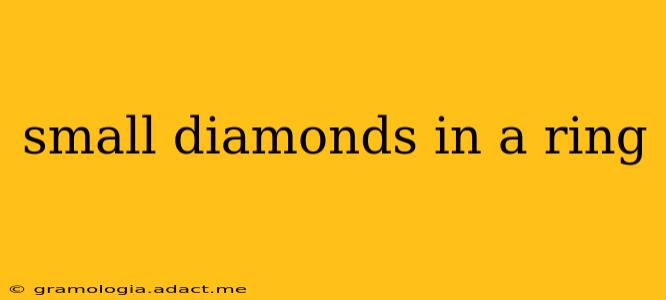Small diamonds, often overlooked, possess a unique charm and elegance that can elevate any ring design. Whether you're considering a delicate solitaire, a dazzling cluster, or a pave setting, understanding the nuances of small diamonds is crucial to making an informed choice. This guide explores everything you need to know about selecting small diamonds for your ring, addressing common questions and concerns along the way.
What are the benefits of using small diamonds in a ring?
Small diamonds offer a multitude of advantages, making them a popular choice for various ring styles. Their affordability is a significant benefit, allowing for more diamonds in a design, creating a greater sense of sparkle and brilliance. The delicate nature of small diamonds lends itself to intricate settings and designs that might be impractical with larger stones. Furthermore, small diamonds are perfect for those who prefer a more understated, subtle elegance.
What is the minimum carat size for a small diamond to be noticeable?
There's no single definitive answer to this question, as "noticeable" is subjective. However, diamonds under 0.20 carats are often considered quite small and might appear less prominent, especially in a simple solitaire setting. Many find that diamonds between 0.20 and 0.30 carats offer a good balance between visibility and affordability. Ultimately, the noticeable size depends on the cut, clarity, and setting of the diamond.
What are the different cuts of small diamonds used in rings?
While brilliant-cut diamonds are popular for their sparkle, smaller diamonds can be successfully cut in a variety of shapes, including:
- Brilliant-cut: The classic round cut, maximizing brilliance. Even small brilliant-cut diamonds can exhibit impressive sparkle.
- Princess-cut: A square or rectangular cut with sharp corners, offering a modern aesthetic.
- Asscher-cut: A square cut with stepped facets, providing a vintage feel.
- Pear-cut: Teardrop-shaped, adding a unique touch to a ring design.
- Marquise-cut: Oval-shaped with pointed ends, offering elongation.
The best cut for small diamonds depends on personal preference and the overall design of the ring.
How do I choose the right clarity for small diamonds in a ring?
In smaller diamonds, inclusions (internal flaws) are less noticeable to the naked eye. Therefore, opting for slightly lower clarity grades, such as SI1 or SI2, can significantly reduce the cost without sacrificing noticeable brilliance. VS1 and VS2 are also good options, representing very slightly included diamonds. However, if you're particularly concerned about clarity, choosing a higher clarity grade is always an option, though it will likely increase the price.
What are some popular settings for small diamonds in rings?
The setting significantly impacts the appearance of small diamonds. Popular settings include:
- Pave Setting: Tiny diamonds are set closely together, creating a continuous band of sparkle.
- Bezel Setting: The diamond is encircled by a metal frame, providing protection and a sleek look.
- Channel Setting: Diamonds are set in a channel between two metal rails.
- Cluster Setting: Several smaller diamonds are clustered together to create the illusion of a larger stone.
- Solitaire Setting: A single small diamond takes center stage, emphasizing its delicate beauty.
The optimal setting depends on the desired aesthetic and overall ring style.
Are small diamonds less durable than larger diamonds?
The durability of a diamond isn't directly related to its size. The cut, clarity, and the quality of the setting are more influential factors in a diamond's long-term resilience. A well-cut, well-set small diamond can be just as durable as a larger diamond.
How much do small diamonds in a ring cost?
The price of small diamonds varies considerably based on the 4Cs (cut, clarity, color, and carat weight). While smaller diamonds are generally more affordable than larger ones, the cumulative cost of multiple small diamonds in a pave or cluster setting can add up. It's always advisable to obtain quotes from multiple jewelers to compare prices and options.
Choosing small diamonds for a ring offers a path to exquisite style and affordability. By understanding the factors influencing their appearance and cost, you can confidently select the perfect gems to create a truly special and memorable piece of jewelry. Remember to consult with a reputable jeweler who can guide you through the process and ensure you make the best choice for your needs and budget.
